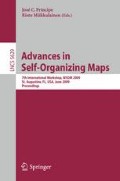Abstract
Swarm-based methods are promising nature-inspired techniques. A swarm of stochastic agents performs the task of clustering high-dimensional data on a low-dimensional output space. Most swarm methods are derivatives of the Ant Colony Clustering (ACC) approach proposed by Lumer and Faieta. Compared to clustering on Emergent Self-Organizing Maps (ESOM) these methods usually perform poorly in terms of topographic mapping and cluster formation. A unifying representation for ACC methods and Emergent Self-Organizing Maps is presented in this paper. ACC terms are related to corresponding mechanisms of the SOM. This leads to insights on both algorithms. ACC can be considered to be first-degree relatives of the ESOM. This explains benefits and shortcomings of ACC and ESOM. Furthermore, the proposed unification allows to judge whether modifications improve an algorithm’s clustering abilities or not. This is demonstrated using a set of critical clustering problems.
Access this chapter
Tax calculation will be finalised at checkout
Purchases are for personal use only
Preview
Unable to display preview. Download preview PDF.
References
Aranha, C., Iba, H.: The effect of using evolutionary algorithms on ant clustering techniques. In: Pham, L., Le, H.K., Nguyen, X.H. (eds.) Proceedings of the Third Asian-Pacific workshop on Genetic Programming, Military Technical Academy, Hanoi, VietNam, pp. 24–34 (2006)
Fernandes, C., Mora, A., Merelo, J.-J., Ramos, V., Gimenez, J.: KANTS: Artificial Ant System for Classification. In: Ant Colony Optimization and Swarm Intelligence - Proceedings 6th Int. Conf., Brussels, Belgium (2008)
Fisher, R.A.: The use of multiple measurements in taxonomic problems. In: Annals of Eugenics, Part II, vol. 7, pp. 179–188. Cambridge University Press, Cambridge (1936)
Goodhill, G.J., Sejnowski, T.J.: Quantifying neighbourhood preservation in topographic mappings. In: Proc. 3rd Joint Symposium on Neural Computation, California Institute of Technology (1996)
Herrmann, L., Ultsch, A.: Explaining Ant-Based Clustering on the basis of Self-Organizing Maps. In: Proc. of the European Symposium on Artificial Neural Networks (ESANN 2008), Bruges, Belgium (2008)
Nybo, K., Venna, J., Kaski, S.: The self-organizing map as a visual neighbor retrieval method. In: Proc. of the Sixth Int. Workshop on Self-Organizing Maps (WSOM 2007), Bielefeld (2007)
Kohonen, T.: Self-Organizing Maps. Springer Series in Information Sciences, vol. 30. Springer, Heidelberg (1995, 1997, 2001)
Kohonen, T., Somervuo, P.: How to make large self-organizing maps for nonvectorial data. Neural Networks (15), 8–9 (2002)
Lumer, E., Faieta, B.: Diversity and adaption in populations of clustering ants. In: Proceedings of the Third International Conference on Simulation of Adaptive Behaviour: From Animals to Animats, vol. 3, pp. 501–508. MIT Press, Cambridge (1994)
Tan, S.C., Ting, K.M., Teng, S.W.: Reproducing the Results of Ant-Based Clustering without Using Ants. In: IEEE Congress on Evolutionary Computation (2006)
Fundamental Clustering Problem Suite, http://www.uni-marburg.de/fb12/datenbionik/data
Ultsch, A., Mörchen, F.: U-maps: topograpic visualization techniques for projections of high dimensional data. In: Proc. 29th Annual Conference of the German Classification Society (GfKl 2006), Berlin (2006)
Ultsch, A., Herrmann, L.: Automatic Clustering with U*C, Technical Report, Dept. of Mathematics and Computer Science, Philipps-University of Marburg (2006)
Author information
Authors and Affiliations
Editor information
Editors and Affiliations
Rights and permissions
Copyright information
© 2009 Springer-Verlag Berlin Heidelberg
About this paper
Cite this paper
Herrmann, L., Ultsch, A. (2009). Clustering with Swarm Algorithms Compared to Emergent SOM. In: Príncipe, J.C., Miikkulainen, R. (eds) Advances in Self-Organizing Maps. WSOM 2009. Lecture Notes in Computer Science, vol 5629. Springer, Berlin, Heidelberg. https://doi.org/10.1007/978-3-642-02397-2_10
Download citation
DOI: https://doi.org/10.1007/978-3-642-02397-2_10
Publisher Name: Springer, Berlin, Heidelberg
Print ISBN: 978-3-642-02396-5
Online ISBN: 978-3-642-02397-2
eBook Packages: Computer ScienceComputer Science (R0)

